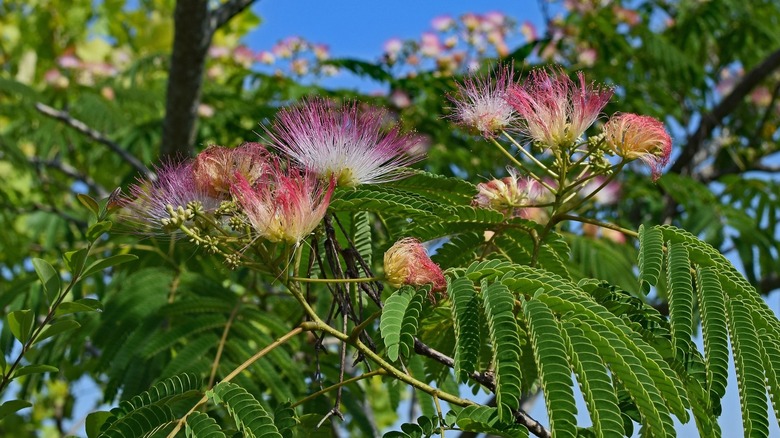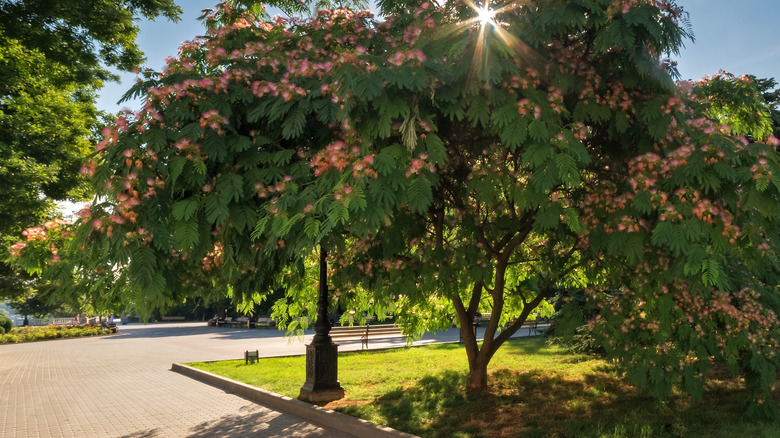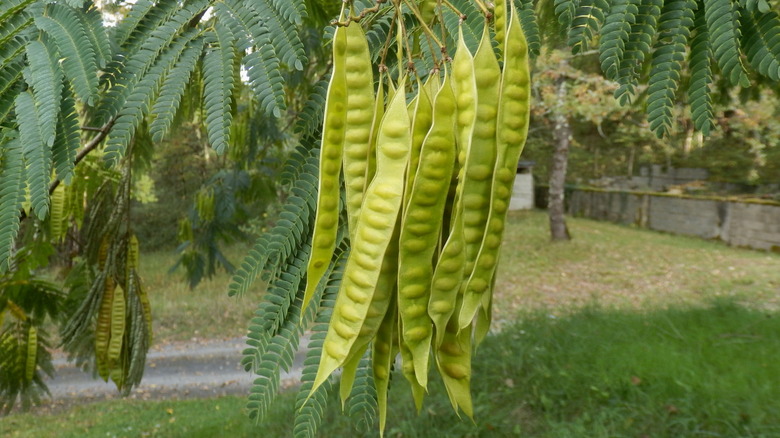You Might Want To Rethink Growing A Mimosa Tree In Your Yard
Selecting beautiful trees to decorate your yard with is one of the many appeals of home gardening. It's no wonder that people come across the mimosa tree (Albizia julibrissin) and instantly fall in love with its intricate palm-like leaves and silky pink flowers. Unfortunately, you might want to rethink growing a mimosa tree in your yard because of the dangers associated with it. You don't want to plant a tree for aesthetic purposes only to have it turn into a hideous spectacle, become invasive, or a harbor for pests. Mimosa trees may be incomparable in terms of beauty, but they can be a headache in the long term.
Like all plants, mimosa trees, aka Persian silk trees, have their pros and cons, but their list of disadvantages seems to be inexhaustible. Beauty fades, and the same can be said for these trees. The mimosa's eye-catching foliage unfortunately only lasts briefly, usually for a few weeks. Of course, the blooming cycle of your mimosa depends on the climate of the region, the nutrients it receives, and the soil conditions, and it typically happens from May to June. Generally speaking, after it blooms, it isn't much to look at except dull green and brown seed pods. There are several other downsides to having a mimosa tree in your yard that go beyond just looks.
Mimosa trees are invasive and their seeds toxic
The mimosa tree is a hardy plant, but that's not good news for the rest of your garden because they're also very invasive, thanks in part to their vigorous roots as well as their seed pods. These seeds are readily distributed by animals as well as the elements, with trees popping up anywhere the seeds land as they can survive in a great many types of soil. That means along your sidewalks, and even in other parts of your yard you didn't plan for. They also grow extremely quickly. Because the seeds are very well-preserved, they can stay viable for a lengthy period.
If the numerous seeds don't sound like a huge problem to you, you might reconsider that when you learn how toxic they are to animals like dogs and livestock, per the Alabama Cooperative Extension System. Your precious furry friend could be put at risk if they decide to chew on the seeds. Your grazing farm animals could drop by the dozens if they get curious enough to nibble on them, too.
Mimosa trees have a relatively short lifespan of about 10 to 20 years. While that may seem long to some people, it's probably not ideal if you're looking for a tree to nurture for your grandkids to roughhouse with. Not that they could do much anyway — the mimosa tree has very weak limbs that are threatened by heavy wind or snow. One bad winter and it's game over.
Pests and diseases can quickly overwhelm mimosas
Mimosa trees are highly susceptible to pests and diseases, with Fusarium wilt being one of the deadliest. Once it takes hold, the tree is almost as good as dead. The fungus prevents vital nutrients from being distributed throughout the tree. Yellow, wilted leaves are tell-tale signs your tree is diseased and if you cut off a piece of the tree roots or bark, you'll notice brown lines in the wood. The affected branches eventually fall off. There is no cure for this and the only "solution" is to plant varieties of mimosas that are more resistant to the fungus.
The mimosa webworm is one of the pests of the mimosa tree. The caterpillar spins the damaged leaves together in a web, feeding from them until they are browned and wilted. Two generations of caterpillars are produced every year but you can control this pest by treating the tree with specialized insecticides.
The carpenterworm is another mimosa pest that gets its name from the way it bores into the sapwood of the tree to feed on it. This leaves holes, scarring, and dark patches on the tree bark, eventually weakening and killing the branches. With small populations, treatment involves killing the larvae by inserting a sharp, thin object into their holes and stabbing them. Larger infestations might call for the affected branches or the entire tree to be removed completely.



